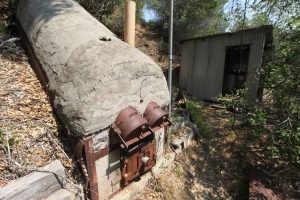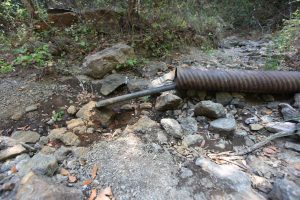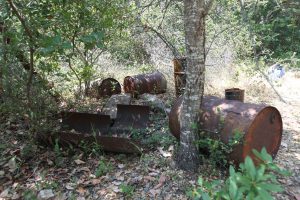30 November 2016
Little mine in Big Sur: Perpetuating mercury contamination in California’s Central Coast
Posted by larryohanlon
By Emma Hiolski
As the Soberanes Fire spread southward along California’s Central Coast in July, August and September, 2016, Michelle Hanan anxiously tracked the burn zone’s progress online through Cal-Fire’s website. The fire, started on July 22 by an illegal campfire, crept toward an abandoned mercury mine in the southern spur of the Los Padres National Forest.
Nestled in the coastal Santa Lucia Mountains, the Old Murry Mine produced 1,000 pounds of mercury before it was shut down in the 1950s, Hanan says. She and her colleagues at Moss Landing Marine Lab and the Ventana Wilderness Alliance were concerned not only about her field site’s destruction, but about whether the fire might spread any of the harmful chemicals left over from the mine’s active days.
Hanan, a master’s student at Moss Landing Marine Lab, is studying how far contamination from this small, remote mine has spread into the surrounding forest. She is collecting soil and insects to measure mercury around the mine and nearby watershed, and will compare them to a non-contaminated watershed further north.

The apparatus used to extract mercury from cinnabar – a retort – sits idle at the Old Murry Mine in California’s Santa Lucia Mountains. Photo credit: Isaiah Neeld.
“I’m hoping to better understand mercury cycling,” she says, “and see how it moves through the environment.”
To get a measure of environmental contamination, Hanan is measuring mercury in soil and predatory insects. Mercury builds up in smaller insects, like flies, gnats and small spiders, through soil and plants. Larger insects feed on them and accumulate even more mercury with each meal. Wolf spiders and water striders are Hanan’s bugs of choice, as higher mercury levels are easier to measure accurately. She will sample starting at the mine, traveling along the Dutra Creek to San Carpoforo Creek, and hopefully all the way to the Pacific Ocean through the rugged terrain.
Microbes can convert environmental mercury to a toxic chemical form, methylmercury, that can poison wildlife and humans. It is especially pervasive in aquatic environments. The most common example is the mercury build-up in fatty tissues of fish and marine mammals. Hanan also plans to test shellfish at the mouth of San Carpoforo Creek to see whether mercury from Old Murry Mine has traveled as far afield as the ocean.
In high doses, mercury exposure can impair vision, hearing, and speech. It can also disrupt muscle coordination, causing tremors and poor balance. Young children and fetuses are especially sensitive to mercury’s neurological effects.

A pipe extending from the hillside under the mine drips steadily into a small tributary of Dutra Creek, which feeds into San Carpoforo Creek. Photo credit: Isaiah Neeld.
California is one of the few mercury-rich places in the world. Mercury is found here naturally as cinnabar, a chemical fusion of mercury and sulfur that creates bright red rocks or crystals. Gold miners heavily exploited these deposits during the California gold rush, as mercury facilitates gold extraction from soil and ore. North America’s two largest, most productive mercury mines were both in California’s Central Coast region. The largest North American mine, the New Almaden Quicksilver Mine in San Jose, California, produced nearly 84 million pounds.
Though the Old Murry mine is small by comparison, contamination is still a problem. In addition to mercury, lead and asbestos permeate the mine’s surroundings. Fuel drums lie haphazardly under trees and lead paint buckets are strewn about, rusting remnants of mining activity. A large pipe from under the mine drips into a small creek bed. Hanan and her colleagues are careful not to touch more than they need to, and avoid eating anywhere near the site.

Diesel fuel drums left behind at Old Murry Mine in the Los Padres National Forest on California’s Central Coast. Photo credit: Isaiah Neeld.
Wildfires can perpetuate mercury contamination by releasing it from soil and plants and spreading it through smoke and ash. It doesn’t take much heat to convert mercury to a gas. Kenneth Coale, Hanan’s advisor and a professor of chemical oceanography at Moss Landing Marine Labs, points out that mercury’s boiling point, 674°F, “is below the temperature you’d bake a pizza at” (typically 700-800°F). Wildfires burn at around 1,000°F, and though soil temperatures are typically lower (~200°F), they can peak at 700-1,000°F.
“These soils are naturally high in mercury, and so forest fires in these regions are likely to emit higher levels of mercury than you’d find in, say, the Sierras,” said Coale.
Studies in other states, including Minnesota, Washington State and Oregon, show that wildfires increase mercury loss from soil. Once released, most of the mercury is redeposited nearby, either through ash or precipitation; the remainder is transported further into the atmosphere and carried across the globe.
Though she isn’t sure how a wildfire would impact mercury contamination near the Old Murry mine, Hanan thinks her project will help fill in gaps about how much mercury is in the surrounding forest, and where contamination has spread thus far.
Luckily the Soberanes Fire did not burn through the Old Murry Mine, though it may be only a matter of time. Climate change and human activity have increased wildfire frequency and intensity over the past few decades, making it more important than ever to understand how mercury is transported through this environment.
Hanan hopes her research will help spur cleanup efforts if she finds that “even my small old little abandoned mine has the potential to contaminate the marine environment.”
Emma Hiolski is a graduate student at the UC Santa Cruz Science Communication Program. You can read more of her work at her website or on Twitter.



 GeoSpace is a blog on Earth and space science, managed by AGU’s Public Information staff. The blog features posts by AGU writers and guest contributors on all sorts of relevant science topics, but with a focus on new research and geo and space sciences-related stories that are currently in the news.
GeoSpace is a blog on Earth and space science, managed by AGU’s Public Information staff. The blog features posts by AGU writers and guest contributors on all sorts of relevant science topics, but with a focus on new research and geo and space sciences-related stories that are currently in the news.